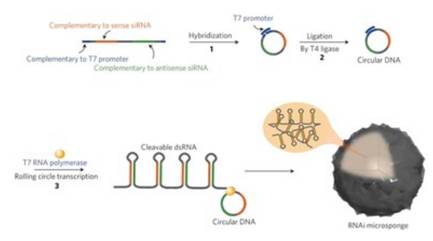近日,美国麻省理工学院科学家开发了一种有效的新型siRNA传递系统,为RNAi治疗包括癌症、神经性障碍和免疫疾病等在内多种疾病带来了巨大的希望。相关研究结果发在Nature Materials杂志上。

缺乏一种有效RNA传递系统一直是阻碍RNAi应用研究的重大问题。美国麻省理工学院科学家开发了一种新型的RNA微粒自组装技术,使得RNA序列能自组装为微粒,且颗粒能够缩小到接近50纳米,从而大大提升了RNA进入细胞的效率。研究者合成出了一条由21个核苷酸重复串联形成的极长链RNA,合成的过程中同时折叠,自组装到微小的、紧密的、直径仅为2微米的球体里。随后在组装完成后球体表面包裹一层带正电的聚合物,帮助球体进一步压缩,并进入到细胞中。微球进入到细胞后,再利用Dicer酶将长链的RNA裂解成siRNA核苷酸片段。超过50万拷贝的基因均能装入RNA微球体中转入细胞中。这一有效的新传递系统为siRNA参与的疾病治疗提供了新途径。
Self-assembled RNA interference microsponges for efficient siRNA delivery
Nat Mater. 2012 Feb 26;11(4):316-22. doi: 10.1038/nmat3253.
Abstract:The encapsulation and delivery of short interfering RNA (siRNA) has been realized using lipid nanoparticles, cationic complexes, inorganic nanoparticles, RNA nanoparticles and dendrimers. Still, the instability of RNA and the relatively ineffectual encapsulation process of siRNA remain critical issues towards the clinical translation of RNA as a therapeutic. Here we report the synthesis of a delivery vehicle that combines carrier and cargo: RNA interference (RNAi) polymers that self-assemble into nanoscale pleated sheets of hairpin RNA, which in turn form sponge-like microspheres. The RNAi-microsponges consist entirely of cleavable RNA strands, and are processed by the cell's RNA machinery to convert the stable hairpin RNA to siRNA only after cellular uptake, thus inherently providing protection for siRNA during delivery and transport to the cytoplasm. More than half a million copies of siRNA can be delivered to a cell with the uptake of a single RNAi-microsponge. The approach could lead to novel therapeutic routes for siRNA delivery.
